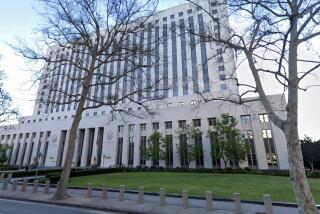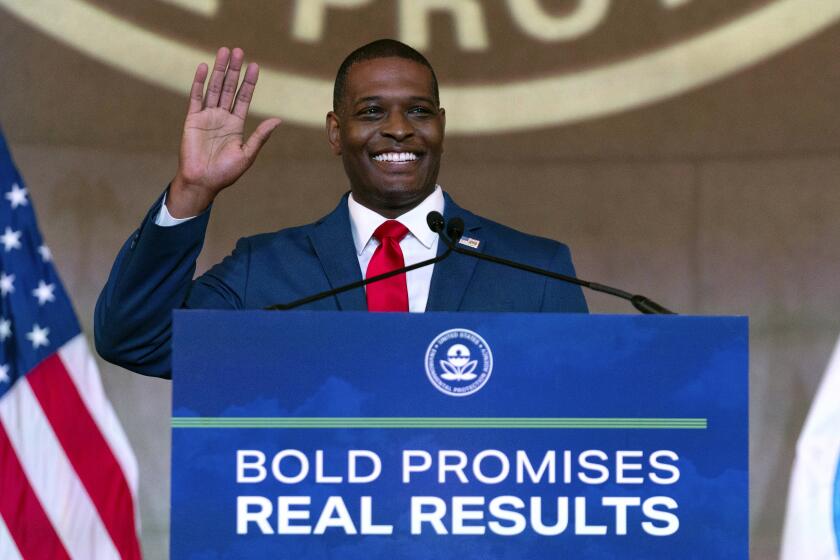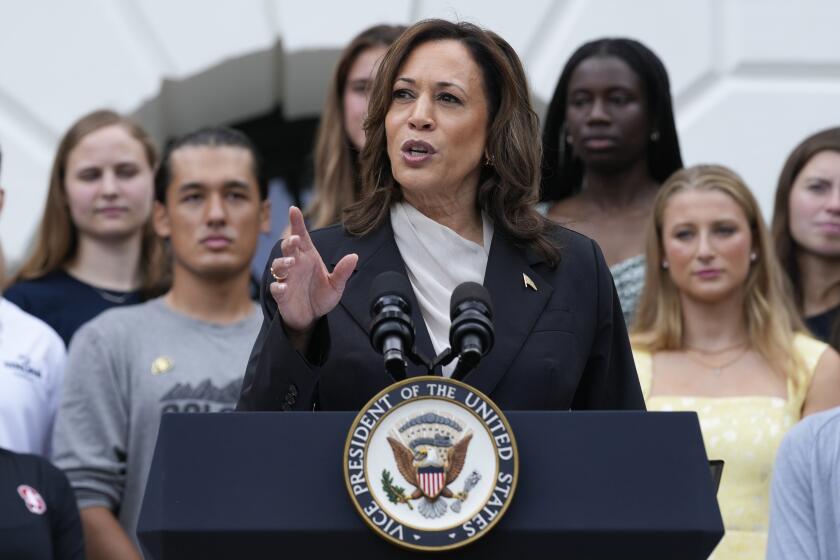Roadblocks to Stop Drunks May Have Worked
Anti-drunk-driving roadblocks set up by the California Highway Patrol during the Christmas holidays had an apparently significant effect--cutting alcohol-related crashes and increasing arrests--according to figures obtained from the patrol and analyzed by a prominent statistician Thursday at the request of The Times.
But, while the roadblock program seemed to have produced some of the results its advocates claimed it would, they were not nearly as dramatic as many proponents said they expected.
The effects of the program--involving what have been euphemistically called “sobriety checkpoints”--was further clouded by two potentially significant factors: drunk-driving fatalities increased, compared to the same 17-day period in 1983, in the four Highway Patrol areas that used roadblocks. And several experts agreed that if the roadblock program had actually functioned as a true deterrent to drunk driving, arrests should have dropped in the affected areas, but they didn’t.
The fatality total involved three deaths in Highway Patrol areas using roadblocks this holiday season versus one death in the four areas last year--figures so small that they are virtually meaningless in a statistical sense.
Opponents of roadblocks point to an increase in drunk-driving fatalities over the holidays. Advocates of the roadblock tactic, most notably the Mothers Against Drunk Driving, immediately contended that the Highway Patrol figures established the effectiveness of the checkpoints. Opponents, including the American Civil Liberties Union, said that the results were ambiguous and that, in any event, they did not bear on the disputed constitutionality of the tactic.
Motorists who were stopped at the roadblocks, moreover, have responded to a Highway Patrol survey assessing the popularity of the technique in numbers far higher than the patrol expected, officials said.
The results of the postcard survey, the patrol disclosed, indicate that 85.5% of motorists responding agree that the roadblocks are a good way to catch drunk drivers and that 83.1% believe that the prospect of encountering roadblocks deters driving under the influence of alcohol or drugs. Another 85.9% said they believe that the roadblocks increase the risk of arrest for drunk driving, and 92.7% said they did not feel that they were unreasonably delayed in their travels by being detained.
A total of 10,150 motorists were stopped in the roadblocks and given survey cards, of which 2,450 were returned, the patrol said--a total significantly greater than commanders were said to have expected. Results of the survey were based on detailed tabulation of only the first 575 responses, but a Highway Patrol spokesman said the proportion of motorists favoring the tactic appeared to be the same for the entire sampling.
The Highway Patrol agreed to supply preliminary statistical totals in response to repeated requests from The Times, cautioning that the agency’s own full analysis of the results of the roadblock program will probably not be available for at least two months. The Highway Patrol figures did not take into account roadblock programs set up by other law enforcement agencies around the state. Burlingame authorities used the tactic before the Highway Patrol, and Santa Ana police and the Los Angeles County Sheriff’s Department are also experimenting with it.
The checkpoints were set up on surface streets in four Highway Patrol office areas across the state--Glendale (whose territory includes parts of the cities of Los Angeles, Pasadena, Glendale, Burbank and La Canada-Flintridge, as well as portions of unincorporated Los Angeles County), Bakersfield, Redding and North Sacramento.
Checkpoints were conducted over a 17-day period starting Dec. 14. To attempt to measure the effects, The Times obtained figures from the entire territories covered by the four roadblock CHP stations for alcohol-related fatalities, all crashes involving drunk drivers and drunk-driving arrests for the same 17-day periods of 1983 and 1982. The figures were compared against statewide totals for the same statistics for 1983 and 1984.
Comparing the identical 17-day periods of 1983 and 1984, roadblock areas recorded a 19% decline in alcohol-related crashes and a 26% increase in drunk-driving arrests. For the rest of the state--areas where the Highway Patrol has never conducted sobriety roadblocks--crashes went down 5% and arrests rose by 8%.
A standard statistical analysis was conducted for The Times Thursday by William Louv, an expert at the University of Alabama School of Public Health in Birmingham who has taught courses in statistics interpretation for journalists and public health officials across the country. Louv said the numbers of arrests and crashes were large enough to support statistically valid conclusions.
Arrests for drunk driving were compared for the entire territory encompassed by the Highway Patrol offices that conducted checkpoints and the rest of the state. There were few arrests at the checkpoints themselves, but patrol commanders said they hoped public awareness of the checkpoints in specific, local areas would deter people in wide areas around the checkpoints from driving while drunk during the holidays. Each of the four offices conducted four or five actual roadblocks.
Based on the analysis, Louv said the results reported by the Highway Patrol are “very suggestive” of a clear, discernable effect of the checkpoints. However, Louv said that to be certain of the true value of the checkpoints as an actual deterrent to drinking and driving, at least one more year of study would be necessary.
“If I were the head of the Highway Patrol, I would conclude that this is a reasonable program,” Louv said. “But it would be interesting to see what happens next year. If the effect is th1696625505 The areas that conducted roadblocks reported a combined total of 91 alcohol-related crashes and 727 drunk-driving arrests this year, compared to 112 accidents and 579 arrests last year. The arrest total for 1983, however, had recorded a decline from 666 a year earlier, apparently because California’s tough new drunk-driving laws took effect.
Statewide, the roadblock period in 1984 saw a total of 1,071 alcohol-related crashes and 8,245 arrests, compared to 1,147 accidents and 7,565 arrests a year earlier. Problems posed by installation of a new computer system to track statewide figures made it impossible to provide 1982 statewide totals for comparison purposes, the Highway Patrol said.
Statewide fatalities were up in 1984, however, from 20 to 27. In roadblock areas, fatalities increased from one to three, though there were also six deaths in the four areas in 1982. The death toll was deliberately excluded from analysis conducted by Louv because the numbers were too small to be statistically significant.
Highway Patrol Commissioner James E. Smith said that he was “extremely pleased” by the apparent results of the roadblock program and that patrol commanders will probably recommend that the tactic be retained on a limited, experimental basis for at least the next year, pending more thorough analysis.
Smith conceded in a telephone interview from Sacramento, however, that the arrest totals could be perceived as contradicting the assertion that the roadblocks would deter drunk driving and, therefore, result in fewer--not more--arrests. He said that Highway Patrol manpower increases in 1984 have put more officers on the road than a year ago and that the simple hike in the number of patrol cars on duty could be tied to increases in the arrest total.
Smith also said he was reluctant to claim that the roadblocks were exclusively responsible for the decrease in alcohol-related crashes in roadblock areas compared to the rest of the state. “That is extremely difficult to conclude on the basis of this small a sample,” Smith said. “Obviously, we are very pleased, but I am reluctant to say that that (the roadblock program) is the sole reason it happened.
“Hopefully, this is one of them.”
Smith said he was especially pleased that such high proportions of motorists stopped in the roadblocks apparently approved of and supported the tactic. “I think we have shown this is not a tremendous inconvenience to the public,” he said. “We don’t have the nightmare of traffic jams and violations of civil rights that some people had predicted.”
The California results are likely to add to a spirited nationwide controversy over roadblocks.
Diane Steed, director of the federal government’s National Highway Traffic Safety Administration, agreed in a telephone interview from Washington that many experts believe that, if drunk-driving roadblocks actually function as a deterrent, arrests in the areas around them should decline, not increase. “Intuitively, I think that is what you would expect,” she said, “but we are just starting on checkpoint programs (nationally), and, for a while, we may not see the result you would expect to see. There are a lot of drunks out there.”
But Steed contended that statistical results are not the most important measurement of the effectiveness of checkpoint programs. “I think the real value is the deterrent and publicity value,” she said. “One of our problems is that we don’t have a way of making sure that drivers who evade arrest know that the risk (of arrest) is there. A checkpoint gives us that opportunity.”
At the Washington-based Insurance Institute for Highway Safety, an organization that has been at the forefront of a wide variety of vehicle safety issues, officials said that checkpoint programs are still too much in their infancy for any final conclusions to be drawn about their true value. The institute, a spokesman noted, is currently conducting a study of checkpoint programs and, significantly, has taken no public position on whether the roadblocks work.
Institute experts also said there are two completely conflicting theories about the effect of roadblocks on drunk-driving arrests. The first theory, a spokesman said, holds that arrests should go down because people are convinced that the roadblocks pose a significant risk of detection. But the other theory is that drunk drivers--especially those who are problem drinkers or alcoholics--are so oblivious to the world around them that they don’t systematically find out about the checkpoints and don’t modify their behavior accordingly.
The institute and other organizations have noted that, while organizations that advocate use of checkpoints have claimed that the roadblocks have been responsible for large reductions in fatalities and drunk-driving accidents in states where they have been utilized, dispassionate measurements are still lacking. Mothers Against Drunk Driving has claimed, for instance, that some roadblock programs have been responsible for a 75% decline in fatalities.
The Greatest Effect About 21 states have experimented with roadblocks.
The institute said checkpoints probably have the greatest effect on casual drinkers. The institute said its still incomplete study is also trying to separate the effect of publicity about roadblock campaigns from that of the sobriety checkpoints themselves--a task that may prove impossible.
Joan Howarth, police practices attorney for the American Civil Liberties Union’s Southern California chapter, said that “obviously these (the figures provided by the Highway Patrol to The Times) are only preliminary statistics, and the ACLU objection to the roadblocks does not depend on the statistical analysis of arrests.
“Rather, what we object to is the fundamental problem of stopping someone without any reasonable basis for doing so.”
The practical results of the checkpoints, Howarth said, “don’t matter” in a constitutional sense. “I think the results aren’t in, anyway,” she said. “Obviously, the checkpoints are just one part of a publicity program that has been going on throughout the state by means of law enforcement agencies and private groups.
“It would be impossible to point the finger at sobriety checkpoints as the cause for any reduction in accidents.”
Howarth said additional changes in state drunk-driving laws that went into effect Jan. 1 and further stiffened penalties may also explain some of the trends noted in the statistical materials. “Those factors are probably important, as well,” she said.
Not surprisingly, the Mothers Against Drunk Driving organization asserted that the decline in accidents and increase in arrests establishes the efficacy of roadblocks. Barbara Bloomberg, president of the group’s Los Angeles chapter, said, “It’s obvious that they worked. They can work and will continue to work.”
“We can reduce accidents and increase awareness of what’s going on,” she said. “But I don’t believe we can measure this (entirely) in terms of figures or statistics. We have to measure it in terms of how many lives were saved through the awareness and knowledge of these roadblocks.
“And that’s always going to be an unknown.”
More to Read
Sign up for Essential California
The most important California stories and recommendations in your inbox every morning.
You may occasionally receive promotional content from the Los Angeles Times.






